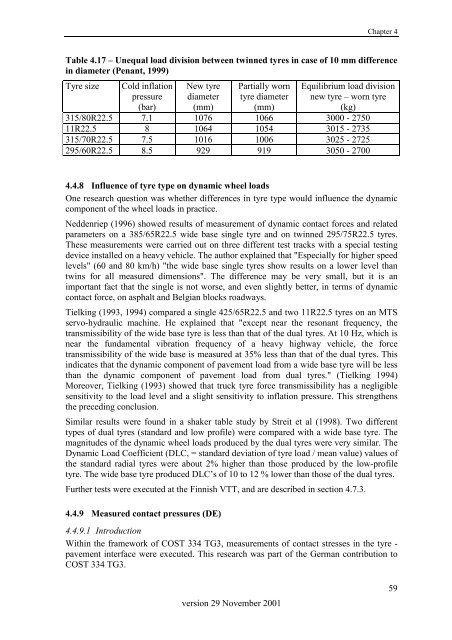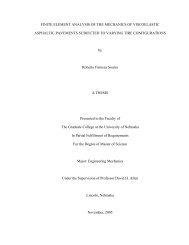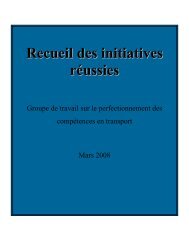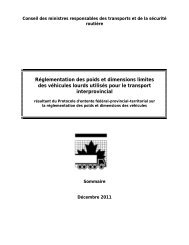Create successful ePaper yourself
Turn your PDF publications into a flip-book with our unique Google optimized e-Paper software.
Chapter 4Table 4.17 – Unequal load division between twinned tyres in case of 10 mm differencein diameter (Penant, 1999)Tyre sizeCold inflationpressure(bar)New tyrediameter(mm)Partially worntyre diameter(mm)Equilibrium load divisionnew tyre – worn tyre(kg)315/80R22.5 7.1 1076 1066 3000 - 275011R22.5 8 1064 1054 3015 - 2735315/70R22.5 7.5 1016 1006 3025 - 2725295/60R22.5 8.5 929 919 3050 - 27004.4.8 Influence of tyre type on dynamic wheel loadsOne research question was whether differences in tyre type would influence the dynamiccomponent of the wheel loads in practice.Neddenriep (1996) showed results of measurement of dynamic contact forces and relatedparameters on a 385/65R22.5 wide base single tyre and on twinned 295/75R22.5 tyres.These measurements were carried out on three different test tracks with a special testingdevice installed on a heavy vehicle. The author explained that "Especially for higher speedlevels" (60 and 80 km/h) "the wide base single tyres show results on a lower level thantwins for all measured dimensions". The difference may be very small, but it is animportant fact that the single is not worse, and even slightly better, in terms of dynamiccontact force, on asphalt and Belgian blocks roadways.Tielking (1993, 1994) compared a single 425/65R22.5 and two 11R22.5 tyres on an MTSservo-hydraulic machine. He explained that "except near the resonant frequency, thetransmissibility of the wide base tyre is less than that of the dual tyres. At 10 Hz, which isnear the fundamental vibration frequency of a heavy highway vehicle, the forcetransmissibility of the wide base is measured at 35% less than that of the dual tyres. Thisindicates that the dynamic component of pavement load from a wide base tyre will be lessthan the dynamic component of pavement load from dual tyres." (Tielking 1994)Moreover, Tielking (1993) showed that truck tyre force transmissibility has a negligiblesensitivity to the load level and a slight sensitivity to inflation pressure. This strengthensthe preceding conclusion.Similar results were found in a shaker table study by Streit et al (1998). Two differenttypes of dual tyres (standard and low profile) were compared with a wide base tyre. Themagnitudes of the dynamic wheel loads produced by the dual tyres were very similar. TheDynamic Load Coefficient (DLC, = standard deviation of tyre load / mean value) values ofthe standard radial tyres were about 2% higher than those produced by the low-profiletyre. The wide base tyre produced DLC’s of 10 to 12 % lower than those of the dual tyres.Further tests were executed at the Finnish VTT, and are described in section 4.7.3.4.4.9 Measured contact pressures (DE)4.4.9.1 IntroductionWithin the framework of <strong>COST</strong> <strong>334</strong> TG3, measurements of contact stresses in the tyre -pavement interface were executed. This research was part of the German contribution to<strong>COST</strong> <strong>334</strong> TG3.version 29 November 200159






